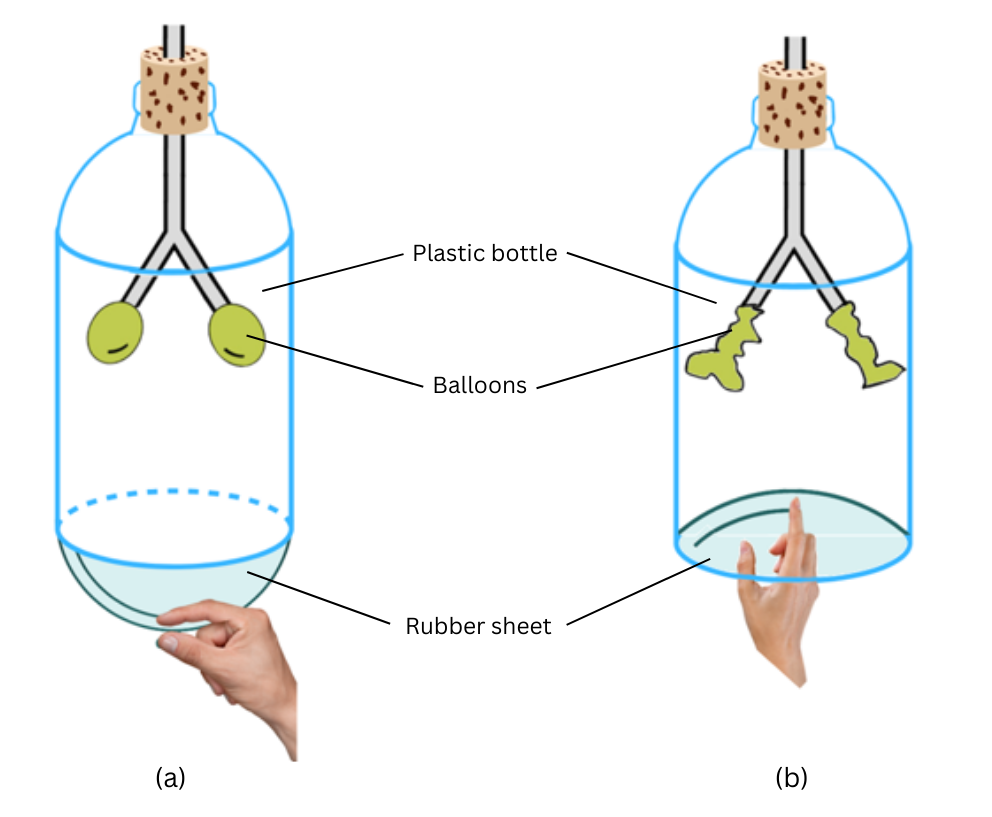5. Complete Activity 6.5 (Page 62). Take a wide plastic bottle. Remove the bottom. Get a Y-shaped glass or plastic tube. Make a hole in the lid so that the tube may pass through it. To the forked end of the tube fix two deflated balloons. Introduce the tube into the bottle. Now cap the bottle. Seal it to make it airtight. To the open base of the bottle tie a thin rubber or plastic sheet using a rubber band. To understand the expansion of the lungs, pull the rubber sheet from the base downwards and watch the balloons. Next, push the rubber/plastic sheet up and observe the balloons. Did you see any changes in the balloons?
What do the balloons in this model represent? What does the rubber sheet represent? Now, you should be able to explain the mechanism of breathing.
Answer:
The Activity 6.5 should be carried out in the following way after procuring the required materials:
Aim: To understand the mechanism of breathing using a model.
Materials Required: Wide plastic bottle, Y-shaped glass or plastic tube, two balloons, cork, rubber or plastic sheet, large rubber band.
Procedure:
(i) Take a wide plastic bottle, remove the bottom and make a hole in the lid.
(ii) To the forked end of the Y-shaped plastic tube fix two deflated balloons.
(iii) Take a piece of cork the size of the bottle opening, make a hole in it and insert the stem of the tube containing the balloons through the cork hole.
(iv) Now insert the Y-shaped plastic tube into the bottle keeping the forked end at the bottom and seal the bottle opening with the cork.
(v) Fasten a rubber sheet to the open base of the bottle using a large rubber band.
The whole contraption is shown in the figure.
(vi) Now pull the rubber sheet from the base of the bottle downwards with your fingers as shown Figure (a). Observe how the shape of the balloons change.
(vii) Next push the rubber sheet upwards with your finger as shown in Figure (b) and observe what happens to the balloons.

Observation:
When you pull the rubber sheet downwards with your fingers you will notice that the balloons will get inflated with air. Conversely when you push the rubber sheet upwards with your finger you will notice that the balloons get deflated. If you keep repeating the activity you will see that the same pattern persists.
Conclusion:
The balloons in this model represent your lungs and the rubber sheet can be thought of as the diaphragm.
The pulling of the rubber sheet downwards increases the space inside the bottle and hence the air pressure inside decreases. Since the air pressure on the balloons decreases, air from outside flows into the balloons and inflates them. This is similar to the downward motion of the diaphragm during expansion of your chest when you inhale which allows the lungs to expand and get filled with air.
When the rubber sheet is pushed upwards the space inside the bottle decreases and the air pressure inside increases. The increased air pressure on the balloons pushes the air out from inside the balloons and deflates them. This is similar to the upward motion of the diaphragm during contraction of the chest cavity when you exhale which allows the lungs to contract and push out the air inside.
Thus, the mechanism of breathing can be explained in terms of this simple model where the balloons represent the lungs and the downward and upward motion of the rubber sheet represent the downward and upward motion of the diaphragm respectively during breathing.
“Complete Activity 6.5 (Page 62). Take a wide plastic bottle. Remove the bottom. Get a Y-shaped glass or plastic tube. Make a hole in the lid so that the tube may pass through it. To the forked end of the tube fix two deflated balloons. Introduce the tube into the bottle. Now cap the bottle. Seal it to make it airtight. To the open base of the bottle tie a thin rubber or plastic sheet using a rubber band. To understand the expansion of the lungs, pull the rubber sheet from the base downwards and watch the balloons. Next, push the rubber/plastic sheet up and observe the balloons. Did you see any changes in the balloons?
What do the balloons in this model represent? What does the rubber sheet represent? Now, you should be able to explain the mechanism of breathing.” – Solved.
Related Links:
Solution to Extended Learning Question 1
Solution to Extended Learning Question 2
Solution to Extended Learning Question 3
Solution to Activity 6.1
Solution to Activity 6.2
Solution to Activity 6.3
Solution to Activity 6.4
Solution to Activity 6.6
Solution to Chapter 6 Respiration in Organisms


